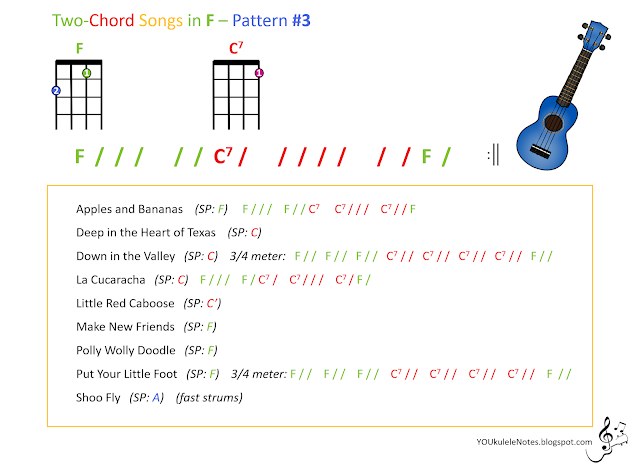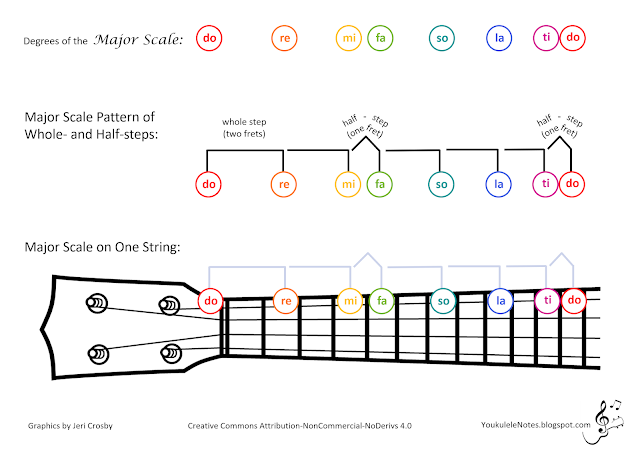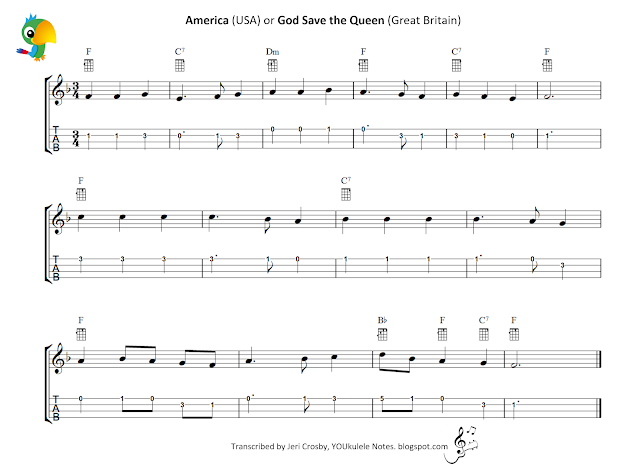Saturday, July 30, 2016
Friday, July 29, 2016
Wednesday, July 27, 2016
Two-Chord Songs in F, Pattern #3
You can play along with these recordings of Polly Wolly Doodle: http://stream.schools.utah.gov/videoarchive/faa2/Track24.mp3 (with voice)
___________________________
_______________________________________
Although this video version is in the key of A (instead of F, so don't play along),
it may be helpful to listen to the melody and
pronunciation here:
https://www.youtube.com/watch?v=9Zvd5Mbdqkg
https://www.youtube.com/watch?v=9Zvd5Mbdqkg
Monday, July 25, 2016
Sunday, July 24, 2016
Saturday, July 23, 2016
Friday, July 22, 2016
Rounds with C and F Chords (I IV)
Note: Although these are two-chord songs, the chord changes are more difficult than songs with F and C7.
I suggest teaching two-chord songs with F and C7 first.
Thursday, July 21, 2016
One-Chord Minor Tunes and Rounds
Wednesday, July 20, 2016
Tuesday, July 19, 2016
Monday, July 18, 2016
Friday, July 15, 2016
Thursday, July 14, 2016
Wednesday, July 13, 2016
Tuesday, July 12, 2016
Monday, July 11, 2016
12-Bar Blues in C
Improvise using two or three notes of the C blues scale while someone plays the 12-bar blues chord progression.
(See instructions at the bottom of my blues scale page.)
Strum along with "Wipeout" by the Surfaris.
Sunday, July 10, 2016
Major Scale Pattern
This is the universal pattern for a major scale.
'Youke' can play a major scale beginning on any note by following this whole- and half-step pattern.
Saturday, July 9, 2016
Minor Scale Pattern
This is the universal pattern for a minor scale.
'Youke' can discover a minor scale by starting on any note and following this whole- and half-step pattern.
Compare and contrast the minor scale to the major scale pattern.
Note: This is the natural minor scale. To create a harmonic minor scale, which sounds a bit more mysterious or tense, raise (sharp) the seventh note a half-step (change so to si).You get to use your fourth finger in the fourth fret for A-flat.
Friday, July 8, 2016
U-Bass Bass-ics: Bass Ukulele
Adding a U-Bass to a ukulele ensemble adds harmonic and rhythmic interest. Use the chart below to visualize the notes on the bass ukulele.
The bass ukulele is tuned differently than other ukes; it is tuned like a string bass or bass guitar: E A D G (from the thickest to thinnest string). Smaller bass ukuleles are tuned an octave higher than indicated in the chart below, but the note names are the same.
The U-bass strings are a perfect fourth (four scale degrees) apart, which makes it easy to create bass patterns based on the bottom note and top note of any triad (first and fifth of any scale).
The simplest way to add bass accompaniment is to play the root (note name) of the chord on the first note of each measure (group of beats). One can also create a more interesting rhythmic pattern using this note.
A more interesting way to create bass accompaniment is to alternate between the bottom note and the top note of a triad. (Triad: three-note chord structure that uses the first, third, and fifth degrees of a scale, e.g., root, skip, skip: A C E or C E G.)
For example, bass back-up for a C chord uses C (root of triad, first note of C scale)
and G (top of triad, fifth note of C scale).
And bass back-up for an F chord uses the root, F (first, main note)
and C (alternating with F).
The second, alternating note may be played higher than or lower than the main/root note. Often when the alternating note is played lower than the root, it will be in the same fret as the first note but on a neighboring string. Have fun adding bass notes to your ensemble!
Blues Scale Pattern
This is the pattern for the BLUES scale.
You can start on any note, and by following the interval pattern (spaces between notes), you'll have the 'blues!'
Compare and contrast the blues scale to the minor scale.
Usually, scales are played across strings (not on just one string).
Read the tablature (TAB) line and play this C blues scale.
Next, sing the note names, reading from the staff.
Then practice reading the scale from the staff.
Improvise using notes from the C blues scale and play along with this B.B. King Style Back-up Track from MyDarnJamTracks on YouTube. At first, only play open C and first and third frets on the E and A strings. Then jazz things up with the 'blue note,' F# (2nd fret on E string). Search for other blues back-up tracks in the key of C. Have fun!
Wednesday, July 6, 2016
Tuesday, July 5, 2016
Monday, July 4, 2016
Subscribe to:
Posts (Atom)


















































